41. Samuel Jackson, Locomotive Engineer
A notable Davenport resident, with some house, family and and street historyDavenport Station home | Index to History pages
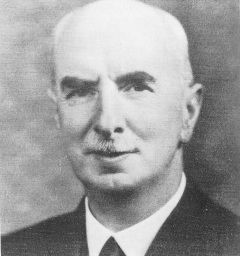
Samuel Jackson, who lived at 260 Bramhall Lane, Davenport from 1928 until his death in 1943, was a significant figure in the history of the World's railways.
Rarely mentioned by local historians, he lived in Stockport all his life, unlike some celebrated 'Stopfordians' whose family moved them away while they were children.
260 Bramhall Lane
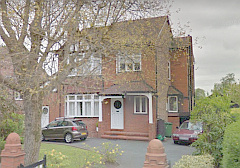
The origin of the house at no. 260 (seen above in 2016 before extension) and its neighbours is covered in detail by our Charlestown feature, but a brief summary is appropriate here.
In 1883, or thereabouts, a large house called 'Charlestown Villa' on the corner of Bramhall Lane and Woodsmoor Lane was purchased by Samuel Kay, a chemical manufacturer. In the following years, he bought from the Freeholder's Company, successors to the Davenports, wide strips of land around his house: along both sides of Bramhall Lane. Perhaps he wanted privacy: nothing was built on the land in his time.
Samuel Kay died in 1917; his wife and son lived in the house until they too both died in 1926. The house, and the land divided into parcels, were sold by auction in May 1927, and the house was demolished.
The land on the eastern side of Bramhall Lane - 3,070 square yards, was sold to a Robert Higginbotham, and the houses 248 to 268 (even) Bramhall Lane built in the fashionable style of the 1920s. Robert Higginbotham, who resided nearby at 'Delamere', 48 Frewland Avenue, is recorded as a house furnisher and Funeral Director. He would have contracted out the actual building; the name of the builder has not yet been discovered.
Beyer Peacock
The Beyer Peacock works in Gorton (not to be confused with the nearby works of the Manchester Sheffield and Lincolnshire) , founded by Charles Frederick Beyer, Richard Peacock and Henry Robertson, completed its first locomotive in 1855, and built steam locomotives of all kinds.
Charles Frederick Beyer (an anglicised form of his original German name Carl Friedrich Beyer) was born in Saxony in 1813, the son of a weaver. He studied engineering at Dresden academy. Moving to England in 1834 he found work in Manchester at the Sharp, Roberts works which built cotton mill machinery, and had begun to produce railway locomotives.
Richard Peacock was born in Healaugh, Swaledale, Yorkshire on 9 April 1820, the seventh son of Ralph Peacock, who when Richard was young, was working on the construction of the Leeds and Selby Railway. The family then moved to Leeds where Richard attended the Grammar School, leaving at 14 for an apprenticeship with locomotive builders Fenton, Murray and Jackson. In 1838, aged just 18, Richard was taken on by the Leeds and Selby Railway as their Locomotive Superintendent,
and by 1841 was chief engineer of Manchester, Sheffield and Lincolnshire Railway's locomotive works in Gorton. He resigned in 1854 to join Beyer, with funding from Henry Robertson, to create their own company.
The larger British railway companies had the resources to build locomotives in their own works, leading Beyer Peacock to establish an export trade which flourished until steam began to be ousted by diesel and electric traction.
They built locomotives of all types, but their most famous product was the Beyer Garratt articulated locomotive: see main text.
Some diesel locos, notably the British Rail 'Hymek' were constructed in later years, but they were not enough to save the company, which finally closed down in 1966.
The final loco to be built at the Beyer Peacock works, although not to a Beyer Peacock design, was British Railways diesel no. D7659. when discarded by BR in 1986 it was saved from the scrap merchant by music producer Peter Waterman. After a period out of use, it returned to working order in 2021, based at 'Peak Rail' in Derbyshire.
Heritage
A number of Beyer Peacock locos have been preserved and can be seen at heritage railways around the UK, although few have survived from Samuel Jackson's days at the company.
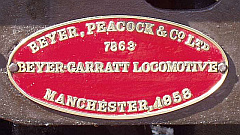
However, his legacy can be seen to great effect on the Welsh Highland Railway between Porthmadog and Caernarfon. The railway has imported from South Africa a number of Garratts, built in the 1950s, which are the maintay of their fleet.
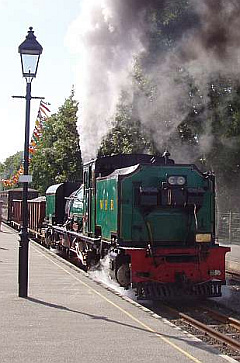
An experiment

The mid-1920s saw Samuel charged with the design and building of an experimental locomotive driven by a Lungström steam turbine, under licence from Swedish company Nydqvist & Holm. He is said to have spent three months in Sweden working with them to produce a workable design.
Steam turbines are more efficient than the locomotive-style reciprocating steam engine, and as such are universally used in static machines such as electricity generators. This one was also to be fitted with a condensing system which re-used the water; it was thought this would appeal to railways in desert areas.
The result was a rather strange-looking beast which was tried out on the London Midland and Scottish Railway, from a base at Derby to Manchester, and later to London, but after a year the complicated machine, which needed much maintenance and cost six times the amount of an ordinary loco was taken back by Beyer Peacock in 1928 and never ran again.
One can't help thinking that Samuel was dubious about this project from the start.
Special thanks to the on-line readers who have added to my knowledge .
Comments welcome:
Charlie@
davenportstation.org.uk
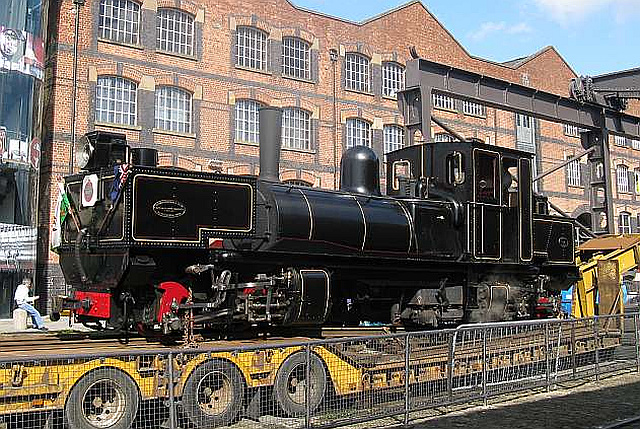
Samuel Jackson, Engineer
The youngest son of the Jackson family, Samuel Jackson was destined for a different career very different from the family trade of barrel-making. He must have shown some aptitude in mechanical matters, and attended classes at Stockport Technical School, which had opened in 1889 on a site in Greek Street, the nucleus of the present-day Stockport College. In 1896 he was enrolled as a premium apprentice by the London & North Western Railway at Crewe Works, under the control of the famous F. W. Webb. (The term 'premium apprentice' means that the family were required to pay for his training.)
Competing his Crewe apprenticeship in 1900, Samuel returned to Stockport, and by 1901 was living, described as a mechanical engineer, at 21 Florist Street with his mother Susan, his sister Susan who was working as a confectioner, and sister Bertha, a student. He spent three years as a pupil in Beyer Peacock's works at Gorton, east Manchester, involving a few months in each department. He completed his pupilage in the drawing office in 1903, thus serving a seven-year apprenticeship. Unusually for the time, he was then immediately employed by the company as a draughtsman.
In 1913 Samuel was promoted to Assistant Works Manager, then Works Manager from 1918 to 1924, then Chief Designer and Works Manager from 1925. He died in 1943; at the time, the company were about to invite him to join the Board of Directors, Other sources say he was made a company director in 1942, which would make him a rare example of someone staying with one company from apprentice to director.
Beyer-Garratt
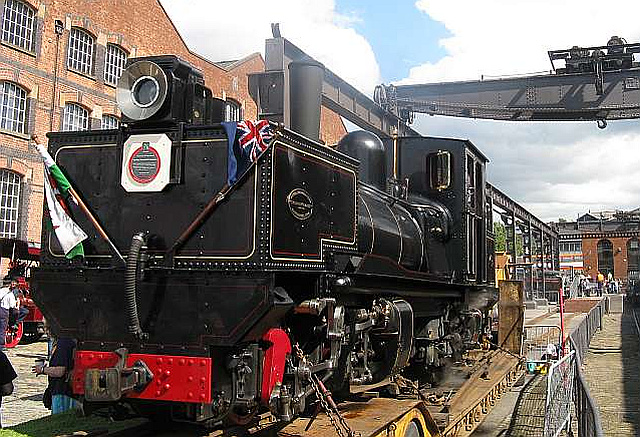
The first-ever Beyer-Garratt locomotive, Built 1909. On display at Manchester Museum of Science and Industry, 2009. Designed by H.W. Garratt and Samuel Jackson.
It was in 1907 that the Beyer Peacock firm was approached by H.W. Garratt, who had patented an idea for an articulated locomotive that could cope with sharp curves in the track. Young Samuel was given the task of converting the idea into an actual locomotive. It has been said that Jackson rather than Garratt, was the true father of the many Beyer-Garratt locomotives which were built in the following years. Garratt died in 1913.
The very first to emerge, for a railway in Tasmania, still exists, having been brought back by the company. It occasionally runs on the Welsh Highland Railway, where larger and more modern narrow-gauge Beyer-Garratts imported from South Africa work most trains. It is said that the system of articulation was inspired by the Fairlie locomotives used on the Ffestiniog Railway.
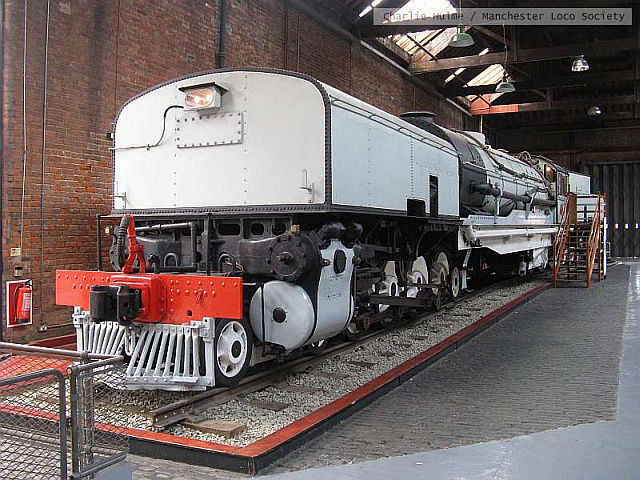
South African Railways Beyer-Garratt no.2352, built at Gorton in 1929.
In later years some very large Beyer-Garratts were produced, effectively two locomotives back to back, fed by one boiler and driven by a single driver. The first really large Beyer-Garratt engine with Samuel involved in the design was for the Nitrate Railway of Chile in 1926; it was of the 2-8-2+2-8-2 type, weighing 187 tons, with a grate area of 69 sq. ft., and was intended for work on grades of 1 in 25.
The example above, a 3ft 6in gauge machine, can be seen in the Manchester Museum of Science and Industry, posed on a length of curved track to see how it articulates (although this part of the museum is closed for restoration at the time of writing).
The Jackson Family
Samuel Jackson was born on 30 December 1879 at 29 Nelson
Street in the Portwood area of Stockport. His father,
born in Stockport in 1843, was John Jackson, a cooper -
maker of wooden barrels - by trade, and his mother
Susan was born in nearby Ashton-under-Lyne in
1844. The firm's products would have been in demand by the many breweries in the area and other industries dealing in liquids. The board on the wall in the distance on Lower Hillgate tells us that they also produced 'turned goods' - wooden objects turned on a lathe; the shop window in the foreground appears to display some small items.
By the time of the 1891 census the family were at 12 Lower Hillgate in the town centre, their home and workshop.
They took over the house and cooperage business from the Rigby family, latterly run by Henry Rigby, who had inherited the business from his father James. James had brought his family to Lower Hillgate from Cronton in Lancashire sometime before 1841 and set up as a cooper. Henry died in 1882.The Jackson family in 1891 were John Jackson (aged 48), wife Susan Jackson (44), with their sons Joseph Jackson (21, Cooper), John Jackson (16, apprentice cooper), Benjamin Jackson (14) and Samuel Jackson (11), daughters Sarah Jackson (19), Susan Jackson (8) and Bertha Jackson (5). Unusually for the period, Benjamin was still a 'scholar' at age 14; he died in 1895. All the children were born in Stockport. (continued below)
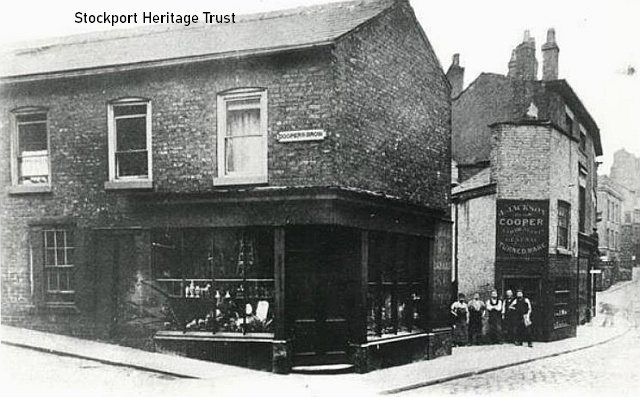
Cooperage became a family business; the picture above, which was taken by local historian John Hurst, and shows the workforce posed outside their shop/workshop at 12 Lower Hillgate, a strange building with no windows on the upper floor. Hurst captions the shop in the foreground as no. 14 Lower Hillgate.
In 1906, Samuel married Florence Wilde (born 1881), and they moved to a modest house at 33 Gill Street in the Brinnington area of Stockport; the 1911 census found them there with their three-year-old daughter Marion Jackson and Samuel's sister Bertha, by then a Head Milliner in the ladies' hat trade.
The 1921 census lists Samuel, Florence, Marion and a second daughter, Edith Jackson, in a semi-detached house at 137 Edgeley Road, Stockport. In 1928, they purchased 260 Bramhall Lane, a newly-built detached house in Davenport, where they remained when the 1939 register listed Samuel (described as Chief Engineer, Loco Works), Florence, and Edith who was working as an assistant nurse. Marion Jackson married John Hallowell Gibson, a master sheet metal worker, in 1930.
The story of Cooper's Brow
While compiling this feature I became interested in the later history of the Jacksons' premises. I hope this may be of interest; any comments are welcome.Jackson's buildings at 12 and 14 Lower Hillgate, and a terrace of cottages (1 t0 4 Cooper's Brow?) set back between the two, were demolished in the 1890s, The Hurst picture above is said to date from before 1892, but an 1896 list still lists the Jacksons at No. 12 (and no. 14 was Thomas Astley, boot maker). Soon afterwards both were replaced by a new building incorporating shops in a typical late-Victorian style, as seen below.
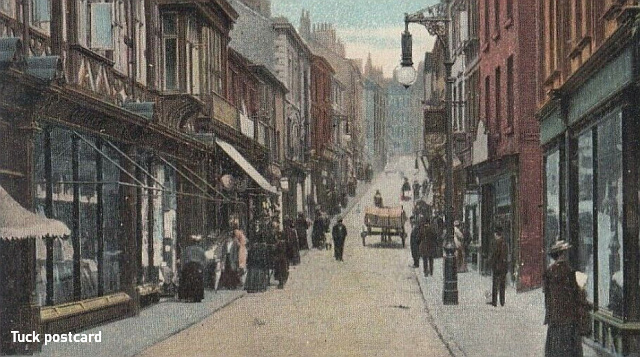
This image, from a postcard sent in 1905, looks in the opposite direction to the 1892 one; The climbing of Cooper's Brow can be glimpse behind the new shops in the right foreground. A 1914 book lists nos. 8-10 Lower Hillgate, nearest to the camera on the right, as Redman Limited, Grocers. This was a long-lived chain store, initially confectioners, and later grocers, with branches around the North-west; not until 1974 did they close most of their branches including this one, while continuing to trade in market halls.
Directories from 1910 to 1934 list Lipton's Limited, provision merchants, at 14, 16 and 16a; did Redman's later buy them out so as to occupy the whole row?
After their father's death in 1893, Joseph and John (junior) continued the business, which in 1910 was listed as J. & J. Jackson, Cooper's Brow, Lower Hillgate, close to their original site. The same year, an entry in the Land Registry refers to Joseph Jackson taking out a 999-year lease on 'Land on the south-west side of 10 Lower Hillgate' from Julia Catherine Wright of Mottram Hall, Mottram St Andrew, heiress of Henry Wright (a family tree can be found online) who had been the incumbent of St Peter's church in Stockport. The exact area of this land is not clear. The 1923 street directory has no mention of the Jackson's cooperage business.
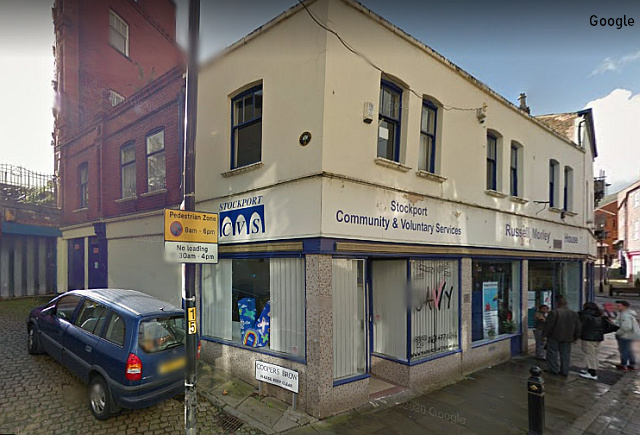
Later, possibly in 1948 - does anyone know when and why? - the ornate Edwardian shop was replaced by the rather utilitarian structure shown in the picture above, which clearly once traded as a shop with large windows and decorative mosaic tiles between. By the 1980s the building, by then numbered 8 to 16, became 'Russell Morley House', as seen in the 2002 image above, named after the Vice President of Age Concern Stockport who died in 1989. This became a centre for volunteer groups in the area.
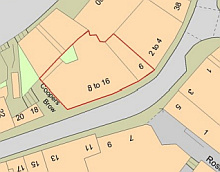 Unfortunately, in 2013 the neighbouring
building at 6 Lower Hillgate collapsed, and Russell Morley
House was deemed possibly unsafe and had to be vacated.
At the time of writing (2022) it is intended to
replace the buildings, which are in poor condition, with new
residential developments.
Unfortunately, in 2013 the neighbouring
building at 6 Lower Hillgate collapsed, and Russell Morley
House was deemed possibly unsafe and had to be vacated.
At the time of writing (2022) it is intended to
replace the buildings, which are in poor condition, with new
residential developments. References, and Further Reading
The most comprehensive obituary of Samuel Jackson as an engineer was published by the Institution of Locomotive Engineers in 1944 and is available on-line at Grace's Guide.
Many books and articles have been written about Beyer Peacock and its locomotives. A comprehensive work is R.L. Hills and D. Patrick, Beyer Peacock, Locomotive builders to the World. Glossop : Transport Publishing Company, 1982.
The Manchester Museum of Science and Industry, which hold the Beyer Peacock archive has a detailed on-line history of the company.
The story of the Lungström locomtive is told in The Self Site and Railway Wonders of the World,
Details of Samuel's family life and homes was compiled from Ancestry.co.uk, Findmypast, the British Newspaper Archive, and the Land Registry. Street directories from our own collection.
The John Hurst image of Cooper's Brow is from the collection of the Stockport Heritage Trust.
History of Age Concern Stockport for Russell Morley House.
Our John Cassidy website for more about Richard Peacock.
Compiled by Charlie Hulme, August 2022.